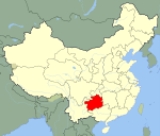
Guizhou
Encyclopedia
is a province of the People's Republic of China
located in the southwestern part
of the country. Its provincial capital city is Guiyang
.
from about the third to the first centuries BCE, Guizhou was home to the powerful and independent Yelang
polity, which covered parts of modern day Guizhou, Hunan
, Sichuan
and Yunnan
provinces.
During the 8th and 9th centuries in the Tang Dynasty
, Chinese soldiers moved into Guizhou (Kweichow) and married native women, their descendants are known as Lao-han-jen (original Chinese), in contrast to new chinese who colonized Guizhou at later times. They still speak an archaic dialect. Many immigrants to Guizhou were descended from these soldiers in garrisons who married non Chinese women.
It was not until the Ming Dynasty
that it came under heavy Chinese settlement and domination during which it was made a province. This prompted mass migration from Sichuan
, Hunan
and its surrounding provinces into Guizhou. The Miao revolted several times against Ming during the Miao Rebellions (Ming Dynasty)
.
During the Qing Dynasty
, Han Chinese soldiers moved into the Taijiang region of Guozhou, married Miao women, and the children were brought up as Miao.
Many rebellions by its native Miao people
occurred throughout the Qing Dynasty
like the one in 1735
, or (one of the longest) the uprising of 1795-1806
. It was said in the Qing Dynasty that every thirty years there would be minor revolts, while every sixty years there would be major rebellions. All the revolts would be violently suppressed by the government.
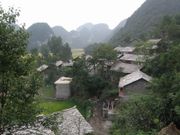 Guizhou adjoins Sichuan
Guizhou adjoins Sichuan
Province and Chongqing Municipality to the north, Yunnan
Province to the west, Guangxi
Province to the south and Hunan
Province to the east. Overall Guizhou is a mountainous province however it is more hilly in the west while the eastern and southern portions are relatively flat. The western part of the province forms part of the Yunnan-Guizhou Plateau.
Other cities include: Anshun
, Kaili, Zunyi
, Duyun, Liupanshui
and Qingzhen
.
Guizhou has a subtropical humid climate. There are few seasonal changes. Its annual average temperature is roughly 10 to 20 °C, with January temperatures ranging from 1 to 10°C and July temperatures ranging from 17 to 28 °C.
Like in China's other southwest provinces, rural areas of Guizhou suffered severe drought during spring 2010. One of China's poorest provinces, Guizhou is experiencing serious environmental problems, such as desertification and persistent water shortages. On 3–5 April 2010, China's Premier Wen Jiabao
went on a three days inspection tour in the southwest drought-affected province of Guizhou, where he met villagers and called on agricultural scientists to develop drought-resistant technologies for the area.
.
The Governor of Guizhou is the highest ranking official in the People's Government of Guizhou. However, in the province's dual party-government governing system, the Governor has less power than the Guizhou Communist Party of China
Provincial Committee Secretary, colloquially termed the "Guizhou CPC Party Chief".
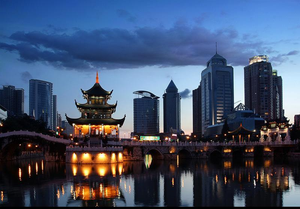 Guizhou is a relatively poor and economically undeveloped province, but rich in natural, cultural and environmental resources. Its nominal GDP for 2009 was 389.35 billion yuan (57 billion USD). Its per capita GDP of 10,258 RMB (1,502 USD) ranks last in all of the PRC.
Guizhou is a relatively poor and economically undeveloped province, but rich in natural, cultural and environmental resources. Its nominal GDP for 2009 was 389.35 billion yuan (57 billion USD). Its per capita GDP of 10,258 RMB (1,502 USD) ranks last in all of the PRC.
Its natural industry includes timber and forestry. Guizhou is also the third largest producer of tobacco in China, and home to the well-known brand Guizhou Tobacco. Other important industries in the province include energy (electricity generation
) - a large portion of which is exported to Guangdong and other provinces - and mining, especially in coal
, limestone
, arsenic
, gypsum
, and oil shale
. Guizhou's total output of coal was 118 million tons in 2008, a 7% growth from the previous year. Guizhou's export of power to Guangdong
equaled 12% of Guangdong's total power consumption. Over the next 5 years Guizhou hopes to increase this by as much as 50%.
The nine prefecture-level divisions are:
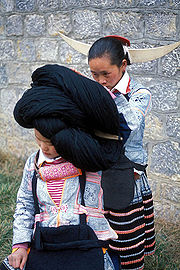 Guizhou is demographically one of China's most diverse provinces. Minority groups account for more than 37% of the population and they include Miao
Guizhou is demographically one of China's most diverse provinces. Minority groups account for more than 37% of the population and they include Miao
(including Gha-Mu
and A-Hmao
), Yao
, Yi
, Qiang, Dong
, Zhuang, Buyei, Bai, Tujia, Gelao and Sui. 55.5% of the province area is designated as autonomous regions for ethnic minorities. Guizhou is the province with the highest fertility rate
in China, standing at 2.19. (Urban-1.31, Rural-2.42)
, distillers of Maotai
liquor, China's most famous alcoholic beverage. The Chinese name of the distillery is Zhongguo (China) Guizhou Maotai Jiuchang (Wine factory)/ China Guizhou Maotai Wine Factory (simplified: 中國貴州茅台酒厂).

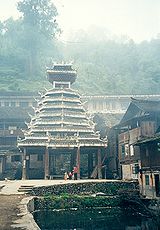 The province has many covered bridge
The province has many covered bridge
s, called Wind and Rain Bridges. These were built by the Dong minority people
.
The southeastern corner of the province is known for its unique Dong minority culture. Towns such as Rongjiang, Liping, Diping and Zhaoxing are scattered amongst the hills along the border with Guangxi.
The rich population of minorities in Guizhou allow for a great many ethnic festivals throughout the lunar calendar. During the first lunar month (usually February), the early festival in Kaili (east of Guiyang) celebrates local culture with acts of bullfighting, horse racing, pipe playing, and comedy works.
People's Republic of China
China , officially the People's Republic of China , is the most populous country in the world, with over 1.3 billion citizens. Located in East Asia, the country covers approximately 9.6 million square kilometres...
located in the southwestern part
Southwest China
Southwest China is a region of the People's Republic of China defined by governmental bureaus that includes the municipality of Chongqing, the provinces of Sichuan, Yunnan and Guizhou, and the Tibet Autonomous Region.-Provinces:-Municipalities:...
of the country. Its provincial capital city is Guiyang
Guiyang
Guiyang is the capital of Guizhou province of Southwest China. It is located in the centre of the province, situated on the east of the Yunnan–Guizhou Plateau, and on the north bank of the Nanming River, a branch of the Wu River. The city has an elevation of about 1,100 meters...
.
History
During the Chinese Han DynastyHan Dynasty
The Han Dynasty was the second imperial dynasty of China, preceded by the Qin Dynasty and succeeded by the Three Kingdoms . It was founded by the rebel leader Liu Bang, known posthumously as Emperor Gaozu of Han. It was briefly interrupted by the Xin Dynasty of the former regent Wang Mang...
from about the third to the first centuries BCE, Guizhou was home to the powerful and independent Yelang
Yelang
Yelang , initially known as Zangke , was an ancient political entity first described in the 3rd century BC that was centered in what is now western Guizhou province, China...
polity, which covered parts of modern day Guizhou, Hunan
Hunan
' is a province of South-Central China, located to the south of the middle reaches of the Yangtze River and south of Lake Dongting...
, Sichuan
Sichuan
' , known formerly in the West by its postal map spellings of Szechwan or Szechuan is a province in Southwest China with its capital in Chengdu...
and Yunnan
Yunnan
Yunnan is a province of the People's Republic of China, located in the far southwest of the country spanning approximately and with a population of 45.7 million . The capital of the province is Kunming. The province borders Burma, Laos, and Vietnam.Yunnan is situated in a mountainous area, with...
provinces.
During the 8th and 9th centuries in the Tang Dynasty
Tang Dynasty
The Tang Dynasty was an imperial dynasty of China preceded by the Sui Dynasty and followed by the Five Dynasties and Ten Kingdoms Period. It was founded by the Li family, who seized power during the decline and collapse of the Sui Empire...
, Chinese soldiers moved into Guizhou (Kweichow) and married native women, their descendants are known as Lao-han-jen (original Chinese), in contrast to new chinese who colonized Guizhou at later times. They still speak an archaic dialect. Many immigrants to Guizhou were descended from these soldiers in garrisons who married non Chinese women.
It was not until the Ming Dynasty
Ming Dynasty
The Ming Dynasty, also Empire of the Great Ming, was the ruling dynasty of China from 1368 to 1644, following the collapse of the Mongol-led Yuan Dynasty. The Ming, "one of the greatest eras of orderly government and social stability in human history", was the last dynasty in China ruled by ethnic...
that it came under heavy Chinese settlement and domination during which it was made a province. This prompted mass migration from Sichuan
Sichuan
' , known formerly in the West by its postal map spellings of Szechwan or Szechuan is a province in Southwest China with its capital in Chengdu...
, Hunan
Hunan
' is a province of South-Central China, located to the south of the middle reaches of the Yangtze River and south of Lake Dongting...
and its surrounding provinces into Guizhou. The Miao revolted several times against Ming during the Miao Rebellions (Ming Dynasty)
Miao Rebellions (Ming Dynasty)
The Miao Rebellions were a series of Rebellions of the aboriginal Miao and other aboriginal tribes of southern China. The Ming Dynasty crushed the rebels with overwhelming force...
.
During the Qing Dynasty
Qing Dynasty
The Qing Dynasty was the last dynasty of China, ruling from 1644 to 1912 with a brief, abortive restoration in 1917. It was preceded by the Ming Dynasty and followed by the Republic of China....
, Han Chinese soldiers moved into the Taijiang region of Guozhou, married Miao women, and the children were brought up as Miao.
Many rebellions by its native Miao people
Miao people
The Miao or ม้ง ; ) is an ethnic group recognized by the government of the People's Republic of China as one of the 55 official minority groups. Miao is a Chinese term and does not reflect the self-designations of the component nations of people, which include Hmong, Hmu, A Hmao, and Kho Xiong...
occurred throughout the Qing Dynasty
Qing Dynasty
The Qing Dynasty was the last dynasty of China, ruling from 1644 to 1912 with a brief, abortive restoration in 1917. It was preceded by the Ming Dynasty and followed by the Republic of China....
like the one in 1735
Miao Rebellion (1735–36)
Miao Rebellion 1735-36 – an uprising of autochthonous people from southwest China . The uprising was the greatest of several rebellions of 1720-30. against the Chinese Empire...
, or (one of the longest) the uprising of 1795-1806
Miao Rebellion (1795–1806)
Miao Rebellion 1795-1806 – anti-Chinese uprising in Hunan and Guizhou provinces, during emperor Jiaqing reign, caused by tensions between local populations and Han Chinese immigrants...
. It was said in the Qing Dynasty that every thirty years there would be minor revolts, while every sixty years there would be major rebellions. All the revolts would be violently suppressed by the government.
Geography

Sichuan
' , known formerly in the West by its postal map spellings of Szechwan or Szechuan is a province in Southwest China with its capital in Chengdu...
Province and Chongqing Municipality to the north, Yunnan
Yunnan
Yunnan is a province of the People's Republic of China, located in the far southwest of the country spanning approximately and with a population of 45.7 million . The capital of the province is Kunming. The province borders Burma, Laos, and Vietnam.Yunnan is situated in a mountainous area, with...
Province to the west, Guangxi
Guangxi
Guangxi, formerly romanized Kwangsi, is a province of southern China along its border with Vietnam. In 1958, it became the Guangxi Zhuang Autonomous Region of the People's Republic of China, a region with special privileges created specifically for the Zhuang people.Guangxi's location, in...
Province to the south and Hunan
Hunan
' is a province of South-Central China, located to the south of the middle reaches of the Yangtze River and south of Lake Dongting...
Province to the east. Overall Guizhou is a mountainous province however it is more hilly in the west while the eastern and southern portions are relatively flat. The western part of the province forms part of the Yunnan-Guizhou Plateau.
Other cities include: Anshun
Anshun
Anshun is a prefecture-level city in China in the southwestern province of Guizhou where the famous Huangguoshu Waterfall is located. Within the borders of its prefecture one also finds attractions such as Long Gong Dragon Caves and the Getu River. As of 1999, it had a population of 217,215...
, Kaili, Zunyi
Zunyi
Zunyi is a prefecture-level city in Guizhou province in southwestern China. Along with Guiyang and Liupanshui, it is one of the most important cities of the province...
, Duyun, Liupanshui
Liupanshui
Liupanshui is a city whose urban area has 251,900 inhabitants in Western Guizhou province in the People's Republic of China. The population of its jurisdictional area has exceeded 2,830,000 as of 2006, and it is the second largest city in Guizhou...
and Qingzhen
Qingzhen
Qingzhen is a county-level city under the administration of Guiyang in Guizhou province of the People's Republic of China.-External links:*...
.
Guizhou has a subtropical humid climate. There are few seasonal changes. Its annual average temperature is roughly 10 to 20 °C, with January temperatures ranging from 1 to 10°C and July temperatures ranging from 17 to 28 °C.
Like in China's other southwest provinces, rural areas of Guizhou suffered severe drought during spring 2010. One of China's poorest provinces, Guizhou is experiencing serious environmental problems, such as desertification and persistent water shortages. On 3–5 April 2010, China's Premier Wen Jiabao
Wen Jiabao
Wen Jiabao is the sixth and current Premier and Party secretary of the State Council of the People's Republic of China, serving as China's head of government and leading its cabinet. In his capacity as Premier, Wen is regarded as the leading figure behind China's economic policy...
went on a three days inspection tour in the southwest drought-affected province of Guizhou, where he met villagers and called on agricultural scientists to develop drought-resistant technologies for the area.
Politics
The politics of Guizhou is structured in a dual party-government system like all other governing institutions in mainland ChinaMainland China
Mainland China, the Chinese mainland or simply the mainland, is a geopolitical term that refers to the area under the jurisdiction of the People's Republic of China . According to the Taipei-based Mainland Affairs Council, the term excludes the PRC Special Administrative Regions of Hong Kong and...
.
The Governor of Guizhou is the highest ranking official in the People's Government of Guizhou. However, in the province's dual party-government governing system, the Governor has less power than the Guizhou Communist Party of China
Communist Party of China
The Communist Party of China , also known as the Chinese Communist Party , is the founding and ruling political party of the People's Republic of China...
Provincial Committee Secretary, colloquially termed the "Guizhou CPC Party Chief".
Economy

Its natural industry includes timber and forestry. Guizhou is also the third largest producer of tobacco in China, and home to the well-known brand Guizhou Tobacco. Other important industries in the province include energy (electricity generation
Electricity generation
Electricity generation is the process of generating electric energy from other forms of energy.The fundamental principles of electricity generation were discovered during the 1820s and early 1830s by the British scientist Michael Faraday...
) - a large portion of which is exported to Guangdong and other provinces - and mining, especially in coal
Coal
Coal is a combustible black or brownish-black sedimentary rock usually occurring in rock strata in layers or veins called coal beds or coal seams. The harder forms, such as anthracite coal, can be regarded as metamorphic rock because of later exposure to elevated temperature and pressure...
, limestone
Limestone
Limestone is a sedimentary rock composed largely of the minerals calcite and aragonite, which are different crystal forms of calcium carbonate . Many limestones are composed from skeletal fragments of marine organisms such as coral or foraminifera....
, arsenic
Arsenic
Arsenic is a chemical element with the symbol As, atomic number 33 and relative atomic mass 74.92. Arsenic occurs in many minerals, usually in conjunction with sulfur and metals, and also as a pure elemental crystal. It was first documented by Albertus Magnus in 1250.Arsenic is a metalloid...
, gypsum
Gypsum
Gypsum is a very soft sulfate mineral composed of calcium sulfate dihydrate, with the chemical formula CaSO4·2H2O. It is found in alabaster, a decorative stone used in Ancient Egypt. It is the second softest mineral on the Mohs Hardness Scale...
, and oil shale
Oil shale
Oil shale, an organic-rich fine-grained sedimentary rock, contains significant amounts of kerogen from which liquid hydrocarbons called shale oil can be produced...
. Guizhou's total output of coal was 118 million tons in 2008, a 7% growth from the previous year. Guizhou's export of power to Guangdong
Guangdong
Guangdong is a province on the South China Sea coast of the People's Republic of China. The province was previously often written with the alternative English name Kwangtung Province...
equaled 12% of Guangdong's total power consumption. Over the next 5 years Guizhou hopes to increase this by as much as 50%.
Economic and Technological Development Zones
- GuiyangGuiyangGuiyang is the capital of Guizhou province of Southwest China. It is located in the centre of the province, situated on the east of the Yunnan–Guizhou Plateau, and on the north bank of the Nanming River, a branch of the Wu River. The city has an elevation of about 1,100 meters...
Economic & Technological Development Area - GuiyangGuiyangGuiyang is the capital of Guizhou province of Southwest China. It is located in the centre of the province, situated on the east of the Yunnan–Guizhou Plateau, and on the north bank of the Nanming River, a branch of the Wu River. The city has an elevation of about 1,100 meters...
National New & Hi-Tech Industrial Development Zone
Administrative divisions
Guizhou is made up of 9 prefecture-level divisions, 88 county-level divisions, and 1543 township-level divisions.The nine prefecture-level divisions are:
| Map | # | Name | Hanzi (S) | Hanyu Pinyin | Administrative Seat | Population (2010 Sixth National Population Census of the People's Republic of China The Sixth National Population Census of the People's Republic of China, also referred to as the 2010 Chinese Census, was conducted by the National Bureau of Statistics of the People's Republic of China with a zero hour of November 1, 2010.... ) |
|---|---|---|---|---|---|---|
| — Prefecture-level city Prefecture-level city A prefectural level city , prefectural city or prefectural level municipality is an administrative division of the People's Republic of China, ranking below a province and above a county in China's administrative structure. Prefectural level cities form the second level of the administrative... — |
||||||
| 6 | Guiyang Guiyang Guiyang is the capital of Guizhou province of Southwest China. It is located in the centre of the province, situated on the east of the Yunnan–Guizhou Plateau, and on the north bank of the Nanming River, a branch of the Wu River. The city has an elevation of about 1,100 meters... |
贵阳市 | Guìyáng Shì | Yunyan District Yunyan District Yunyan District is a district of Guizhou, China. It is under the administration of Guiyang city.... |
2,297,339 | |
| 1 | Bijie Bijie Bijie is a prefecture-level city in northwestern Guizhou province, People's Republic of China.The Daotianhe Reservoir, located to the north of the town was commissioned in 1965 with a rated annual capacity of 6.5 million cubic meters.... |
毕节市 | Bìjíe Shì | Qixingguan District | 6,536,370 | |
| 2 | Zunyi Zunyi Zunyi is a prefecture-level city in Guizhou province in southwestern China. Along with Guiyang and Liupanshui, it is one of the most important cities of the province... |
遵义市 | Zūnyì Shì | Honghuagang District Honghuagang District Honghuagang District is a district of Guizhou, China. It is under the administration of Zunyi city.... |
6,127,009 | |
| 3 | Tongren | 铜仁市 | Tóngrén Shì | Bijiang District | 3,092,365 | |
| 4 | Liupanshui Liupanshui Liupanshui is a city whose urban area has 251,900 inhabitants in Western Guizhou province in the People's Republic of China. The population of its jurisdictional area has exceeded 2,830,000 as of 2006, and it is the second largest city in Guizhou... |
六盘水市 | Liùpánshuǐ Shì | Zhongshan District Zhongshan District, Liupanshui Zhongshan District is a district of Guizhou, China. It is under the administration of Liupanshui city.... |
2,851,180 | |
| 5 | Anshun Anshun Anshun is a prefecture-level city in China in the southwestern province of Guizhou where the famous Huangguoshu Waterfall is located. Within the borders of its prefecture one also finds attractions such as Long Gong Dragon Caves and the Getu River. As of 1999, it had a population of 217,215... |
安顺市 | Ānshùn Shì | Xixiu District Xixiu District Xixiu District is a district of Guizhou, China. It is under the administration of Anshun city.... |
4,324,561 | |
| — Autonomous prefecture Autonomous prefectures of China Autonomous prefectures are one type of Autonomous areas of China, existing at the prefectural level. Autonomous prefectures either have over 50% of the population with ethnic minorities or are historically resided by significant minorities. All autonomous prefectures are mostly dominated, in... — |
||||||
| 7 | Qianxinan (Buyei & Miao) Qianxinan Buyei and Miao Autonomous Prefecture Qianxi'nan Buyei and Miao Autonomous Prefecture is an autonomous prefecture of Guizhou province in the People's Republic of China.-Subdivisions:The prefecture is subdivided into 8 county-level divisions: 1 county-level city and 7 counties... |
黔西南布依族苗族自治州 | Qiánxī'nán Bùyīzú Miáozú Zìzhìzhōu |
Xingyi Xingyi, Guizhou Xingyi is a county level city in Guizhou in southern China. It has an area of 2911 square kilometers and a population of 740,700 as the end of 2003.-History:-External links:*... |
2,805,857 | |
| 8 | Qiannan (Buyei & Miao) Qiannan Buyei and Miao Autonomous Prefecture Qiannan Buyei and Miao Autonomous Prefecture is an autonomous prefecture of Guizhou province in the People's Republic of China. The capital of the prefecture is Duyun... |
黔南布依族苗族自治州 | Qiánnán Bùyīzú Miáozú Zìzhìzhōu |
Duyun Duyun Duyun is the capital of Qiannan Buyei and Miao Autonomous Prefecture in Guizhou province in the People's Republic of China.The area surrounding the city was affected by the Miao rebellion of 1736-36. The city participated in the uprising from the early stages until is was forcefully repressed the... |
3,231,161 | |
| 9 | Qiandongnan (Miao & Dong) Qiandongnan Miao and Dong Autonomous Prefecture Qiandongnan Miao and Dong Autonomous Prefecture is an autonomous prefecture of Guizhou province in the People's Republic of China. The seat of the prefecture is Kaili... |
黔东南苗族侗族自治州 | Qiándōngnán Miáozú Dòngzú Zìzhìzhōu |
Kaili | 3,480,626 | |
Demographics

Miao people
The Miao or ม้ง ; ) is an ethnic group recognized by the government of the People's Republic of China as one of the 55 official minority groups. Miao is a Chinese term and does not reflect the self-designations of the component nations of people, which include Hmong, Hmu, A Hmao, and Kho Xiong...
(including Gha-Mu
Gha-Mu
Gha-Mu are an ethnic group in China. They are from Guizhou and belong to the Hmong people. Many of them are Christians. The number of persons within this group likely exceeds 100,000. Their language is the Hmong language Small Flowery Miao; Large Flowery Miao is another, of the A-Hmao.- Sources :**...
and A-Hmao
A-Hmao
A-Hmao are an ethnic group in China. They are from Yunnan and Sichuan. They also live in Guizhou. The number of persons within this group likely exceeds 400,000. Their language is the Hmong language Large Flowery Miao. Their language displays extensive tone sandhi....
), Yao
Yao people
The Yao nationality is a government classification for various minorities in China. They form one of the 55 ethnic minority groups officially recognized by the People's Republic of China, where they reside in the mountainous terrain of the southwest and south...
, Yi
Yi people
The Yi or Lolo people are an ethnic group in China, Vietnam, and Thailand. Numbering 8 million, they are the seventh largest of the 55 ethnic minority groups officially recognized by the People's Republic of China...
, Qiang, Dong
Dong people
The Dong , a Kam–Sui people of southern China, are one of the 56 ethnic groups officially recognized by the People's Republic of China. They are famed for their native-bred Kam Sweet Rice , carpentry skills, and unique architecture, in particular a form of covered bridge known as the "wind and rain...
, Zhuang, Buyei, Bai, Tujia, Gelao and Sui. 55.5% of the province area is designated as autonomous regions for ethnic minorities. Guizhou is the province with the highest fertility rate
Total Fertility Rate
The total fertility rate of a population is the average number of children that would be born to a woman over her lifetime if she were to experience the exact current age-specific fertility rates through her lifetime, and she...
in China, standing at 2.19. (Urban-1.31, Rural-2.42)
Culture
Guizhou is the home of the Maotai DistilleryKweichow Moutai Company
Kweichow Moutai Company Limited is a state-owned enterprise in China, specializing in the production and sales of Maotai liquor, together with the production and sale of beverage, food and packaging material, development of anti-counterfeiting technology, research and development of relevant IT...
, distillers of Maotai
Maotai
Maotai, or Moutai , is a Chinese liquor, or baijiu.It is produced in the town of Maotai , in the city of Renhuai, Guizhou province, Southwest China. It is believed that the town of Maotai possesses a unique climate and vegetation that contributes to the taste of the drink...
liquor, China's most famous alcoholic beverage. The Chinese name of the distillery is Zhongguo (China) Guizhou Maotai Jiuchang (Wine factory)/ China Guizhou Maotai Wine Factory (simplified: 中國貴州茅台酒厂).
Tourism


Covered bridge
A covered bridge is a bridge with enclosed sides and a roof, often accommodating only a single lane of traffic. Most covered bridges are wooden; some newer ones are concrete or metal with glass sides...
s, called Wind and Rain Bridges. These were built by the Dong minority people
Dong people
The Dong , a Kam–Sui people of southern China, are one of the 56 ethnic groups officially recognized by the People's Republic of China. They are famed for their native-bred Kam Sweet Rice , carpentry skills, and unique architecture, in particular a form of covered bridge known as the "wind and rain...
.
The southeastern corner of the province is known for its unique Dong minority culture. Towns such as Rongjiang, Liping, Diping and Zhaoxing are scattered amongst the hills along the border with Guangxi.
The rich population of minorities in Guizhou allow for a great many ethnic festivals throughout the lunar calendar. During the first lunar month (usually February), the early festival in Kaili (east of Guiyang) celebrates local culture with acts of bullfighting, horse racing, pipe playing, and comedy works.
Colleges and universities
- Guizhou UniversityGuizhou UniversityGuizhou University is a public coeducational university, located in the suburban outskirts of Guiyang, the capital city of Guizhou Province, China. The university is one of the key 211 Project universities on mainland China....
(Guiyang) - Guizhou Normal UniversityGuizhou Normal UniversityGuizhou Normal University is an institution of higher learning in Guiyang, Guizhou Province of the People's Republic of China....
(Guiyang) - Zunyi Medical CollegeZunyi Medical CollegeZunyi Medical College is an medical university in Zunyi, Guizhou province of the People's Republic of China.-History:The college was founded in 1947 as the Dalian Medical College. The college was relocated from Dalian to Zunyi and renamed Zunyi Medical College in 1969...
(Zunyi) - Guiyang Medical UniversityGuiyang Medical UniversityGuiyang Medical University is a public university based in Guiyang, capital of Guizhou province in China.- History :The university was founded in 1938 as the National Guiyang Medical University directly administered by the central government in Beijing...
(Guiyang) - Guizhou Nationalities UniversityGuizhou Nationalities University- History :The university was established in 1951 as the earliest university to cater for indigenous people such as the Zhuang people which populate Guizhou province.- External links :*...
(Guiyang)

